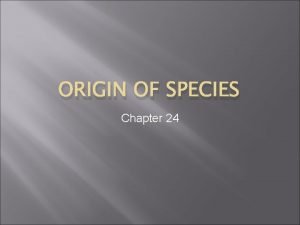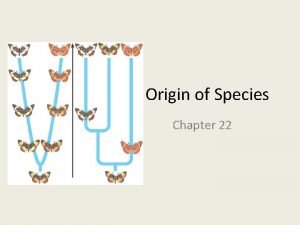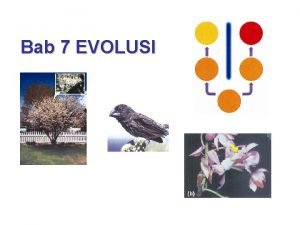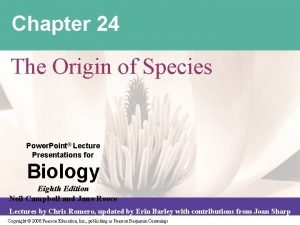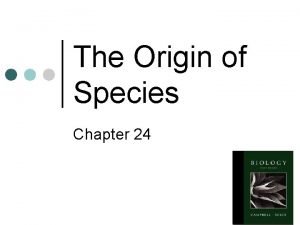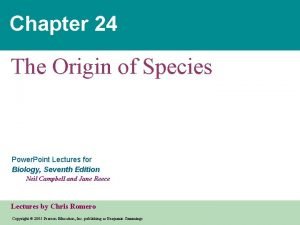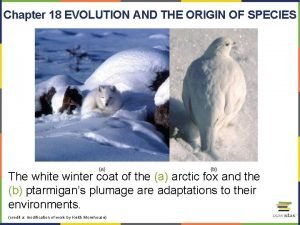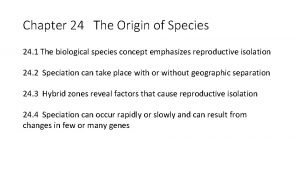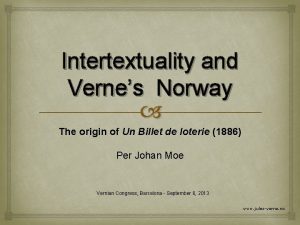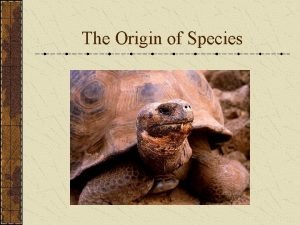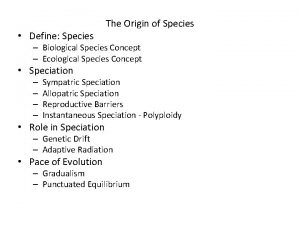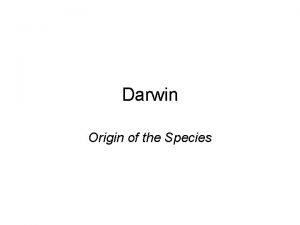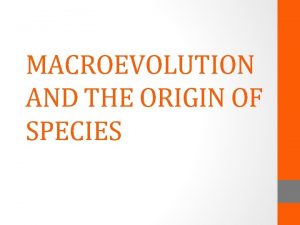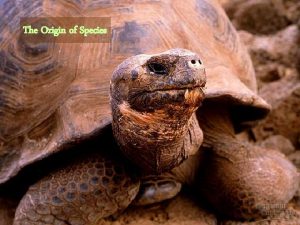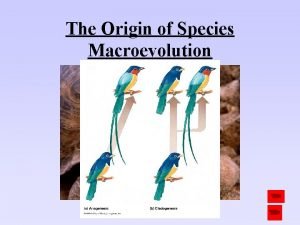Chapter 24 The Origin of Species 24 1











- Slides: 11

Chapter 24 The Origin of Species 24. 1 The biological species concept emphasizes reproductive isolation 24. 2 Speciation can take place with or without geographic separation 24. 3 Hybrid zones reveal factors that cause reproductive isolation 24. 4 Speciation can occur rapidly or slowly and can result from changes in few or many genes

AP BIG IDEAS: Speciation can occur when two populations become reproductively isolated from one another (big idea 1). This can lead to differences in timing and coordination of behavior (big idea 2) and changes in modes of intercellular and intracellular signal transmission (big idea 3). Reproductive isolation can also affect relationships with other species in the environment and bring about adaptation or morphological change (big idea 4). Speciation is the process by which one species splits into two or more species. When one species splits into two, the species that can result share many characteristics because they are descended from a common ancestor. A species is a group of populations whose members have the potential to interbreed in nature and produce viable, fertile offspring – but do not produce fertile, viable offspring with other groups.

Because biological species are defined in terms of reproductive compatibility, the formation of new species hinges on reproductive isolation – the existence of biological factors (barriers) that impede members of two species from interbreeding and producing viable, fertile offspring. Such barriers block gene flow between the species and limit the formation of hybrids, offspring that result from an interspecific mating. These barriers can be classified according to whether they contribute to reproductive isolation before or after fertilization. • Prezygotic barriers (“before the zygote”) block fertilization from occurring. Such barriers act in one of three ways: by impeding members of different species from attempting to mate, by preventing an attempting mating from being completed successfully, or by hindering fertilization if mating is completed successfully. • Postzygotic barriers (“after the zygote”) may contribute to reproductive isolation after the hybrid zygote is formed. Developmental errors may reduce survival among hybrid embryos.

In allopatric speciation, gene flow is interrupted when a population is divided into geographically isolated subpopulations. For example, the water level in a lake may subside, resulting in two or more smaller lakes that are now home to separated populations. Allopatric speciation can occur without geographic remodeling, such as when individuals colonize a remote area and their descendants become isolated from the parent population.

In sympatric speciation, speciation occurs in populations that live in the same geographic area due to factors such as polyploidy, sexual selection, and habitat differentiation. Polyploidy- a species may originate from an accident during cell division that results in extra sets of chromosomes. A tetraploid (4 n) can produce fertile tetraploid offspring by self-pollinating or by mating with other tetraploids. • Autopolyploidy results in an individual that has more than two sets of chromosome sets that are all derived from a single species. • Allopolyploidy occurs when two species interbreed and produce hybrid offspring. Allopolyploids are fertile when mating with each other, but cannot interbreed with either parent species (new species)


Sympatric speciation may also be driven by sexual selection. East Africa’s Lake Victoria was once home to 600 species of cichlids. How did so many species originate within a single lake? One hypothesis is that subgroups adapted to different food sources and the resulting genetic divergence contributed to speciation. Sexual selection in which females select males based on their appearance may have also been a factor. Sympatric speciation can also occur when a subpopulation exploits a habitat or resource not used by the parent population. The apple maggot fly had an original habitat of the hawthorn tree, but about 200 years ago, some populations colonized apple trees. This resulted in a prezygotic barrier (habitat isolation) between populations that feed on apples and those that feed on hawthorn berries.

• In allopatric speciation, a new species forms in geographic isolation from its parent population. • In sympatric speciation, reproductive barriers isolate a subset of a population from the remainder of the population in the same area.

What happens if species with incomplete reproductive barriers come into contact with one another? One possible outcome is the formation of a hybrid zone, a region in which members of different species meet and mate, producing at least some offspring of mixed ancestry.

Reinforcement: Hybrids are often less fit than their parent species. In such cases, natural selection should strengthen prezygotic barriers to reproduction, reducing the formation of unfit hybrids. Fusion: a weakening of reproductive barriers can result in so much gene flow that the gene pools of the two species become increasingly alike. In effect, the speciation process reverses, eventually causing the two hybridizing species to fuse into a single species. Stability: many hybrid zones are stable in the sense that hybrids continue to be produced.

We can gather information about how long it takes new species to form from broad patterns in the fossil record and from studies that use morphological data or molecular data to assess the time interval between speciation events in particular groups of organisms. The fossil record includes many episodes in which new species appear suddenly in geologic stratum, persist essentially unchanged through several strata, and then disappear. Punctuated Equilibria is the term coined to describe these periods of apparent stasis punctuated by sudden change. Other species do not show a punctuated pattern; they appear to have changed more gradually over longer periods of time.
 The origin of species manhwa chapter 24
The origin of species manhwa chapter 24 Gametic isolation
Gametic isolation The origin of species manga 22
The origin of species manga 22 The origin of species chapter 7
The origin of species chapter 7 The origin of species chapter 24
The origin of species chapter 24 Temporal isolation
Temporal isolation The origin of species chapter 24
The origin of species chapter 24 The origin of species 18
The origin of species 18 A keystone species is a species of plants and animals
A keystone species is a species of plants and animals The origin of species manga 24
The origin of species manga 24 The origin of species bl
The origin of species bl Origin of species by charles darwin
Origin of species by charles darwin

